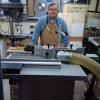My husband was given a 70's era Unisaw by his father. Someone had tried to rewire it for 110 and smoked some stuff. We have had the motor checked out and it is fine. We replaced the Controller and the overload relay. Now when we press the start button the Magnetic contactor makes a noise like it is trying to work ( vibrating ) but nothing starts. We have checked wire connections and believe it is all wired right.
Any suggestions on what could be wrong or what we could try next?




 Reply With Quote
Reply With Quote



 ). Verify that the wires feeding the motor now have correct voltage.
). Verify that the wires feeding the motor now have correct voltage.
